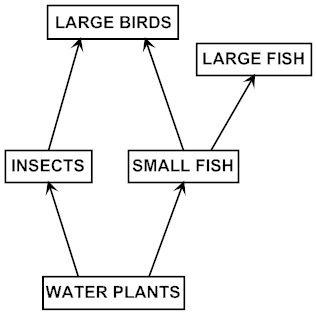Item IE020004: Changes in a population (fish in a pond) may affect populations that are not directly connected in a feeding relationship (large birds).
The diagram below shows the feeding relationships between populations of plants and animals in and around a pond. The arrows point from the organisms being eaten to the organisms that eat them.

More people than usual go fishing at the pond this year and take a lot of the large fish out of the pond. Using only the relationships between the plants and animals shown in the diagram, what effect is this likely to have on the large bird population and why?
- The number of large birds is likely to increase because there will be more small fish for the large birds to eat.
- The number of large birds is likely to decrease because there will be fewer large fish for the large birds to eat.
- The number of large birds is likely to stay the same because large birds and large fish are not connected by an arrow in the diagram.
- The number of large birds is not likely to change because they are higher in the diagram than the large fish, which means that the large birds will not be affected by changes below them in the diagram.
Answer Choice |
Overall |
Grades |
Gender |
Primary Language |
||||
|---|---|---|---|---|---|---|---|---|
| n = 1476 |
6–8 n = 861 |
9–12 n = 613 |
Male n = 694 |
Female n = 765 |
English n = 1336 |
Other n = 103 |
||
| A. | The number of large birds is likely to increase because there will be more small fish for the large birds to eat. | 54% | 52% | 57% | 56% | 52% | 55% | 37% |
| B. | The number of large birds is likely to decrease because there will be fewer large fish for the large birds to eat. | 17% | 17% | 17% | 14% | 19% | 17% | 21% |
| C. | The number of large birds is likely to stay the same because large birds and large fish are not connected by an arrow in the diagram. | 19% | 22% | 16% | 19% | 19% | 19% | 28% |
| D. | The number of large birds is not likely to change because they are higher in the diagram than the large fish, which means that the large birds will not be affected by changes below them in the diagram. | 9% | 9% | 11% | 10% | 9% | 9% | 14% |

